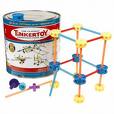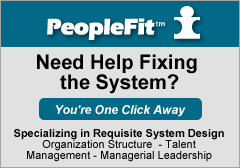Economic Woes Will Spur More Underemployment Which Will Spur More Workplace Woes
By Michelle Malay Carter on February 9, 2009
 Back in May, I blogged about the dangers of overhiring.? With all the clammering to hire the best and the brightest, some managers intentionally overhire for roles.? Sure, these managers have to do less up front training and sure they get more “bang for their buck” – temporarily.? But unless you are building a bench for impending growth, overhiring, i.e. underemploying people, creates an unhealthy workplace environment.?
Back in May, I blogged about the dangers of overhiring.? With all the clammering to hire the best and the brightest, some managers intentionally overhire for roles.? Sure, these managers have to do less up front training and sure they get more “bang for their buck” – temporarily.? But unless you are building a bench for impending growth, overhiring, i.e. underemploying people, creates an unhealthy workplace environment.?
You Can’t Fight Mother Nature
Try as they might, people can simply “check their extra capacity at the door”.? Most managers and employees will be adversely affected by the strain caused by this situation.? I’m talking about?good people with strong work ethics, stellar character, and positive intentions.
Sadly but understandably, with the economy the way it is, there will be more people willing to take jobs that they don’t find challenging.?
Unnatural is Unsustainable
Unfortunately, this is like buying an ill-fitting pair of shoes because you really like the way they look.? It seems like a tolerable situation when you are wearing the shoe for 30 seconds in the store, but when you actually try to go about your life wearing them, it becomes excruciating quite quickly.
Taking a job that you are overqualified for can be a double whammy.? Not only will you be bored with the work within six months, but you stand a good chance of being equally or more cognitively capable than your manager, which then presents a whole host of additional issues.
What the Research Finds
PeopleFit research which has over 5,000 data points finds that on average:
- 35% of employees are mismatched to their roles in terms of cognitive capacity.
- 39% of employees are mismatched to their managers, who should have +1 capacity relative to their direct reports.
Any given employee within an organization can have both mismatch issues listed above.
Employee Engagement
We were not doing well with employee engagement before the economic downturn.? Sigh.? Brace yourselves for impact.? I believe it is going to get worse before it gets better.?
What To Do?? Become Informed
For those of you who want to make more informed, intentional decisions about matching people to roles, I suggest becoming well versed in requisite work levels and human capability to perform work and their critical implications for employee engagement, talent management, and organizational effectiveness.
I’m OK.? You’re OK.? Let’s fix the system.
Have you ever been underemployed?? How did it feel?? How was your relationship with your manager?
Filed Under Employee Engagement, Managerial Leadership, Requisite Organization, Talent Management, Work Levels | 3 Comments
The Amazing Talent Management Solution Calculator – A Friday Funny
By Michelle Malay Carter on February 5, 2009
 Finally,?we can do talent management strictly by the numbers.??Just imagine, solutions based upon an amazing,?recently discovered,?ancient Chinese algorithm.
Finally,?we can do talent management strictly by the numbers.??Just imagine, solutions based upon an amazing,?recently discovered,?ancient Chinese algorithm.
Sweet Success
Organizations the world over are finding their way back to health, prosperity, and employee engagement after choosing the solution suggested via the algorithm.
Instructions:
-Choose your most pressing problem from the list below:
- Our engagement numbers are horrific.
- We dump a lot of money into training, but it isn’t helping.
- Everyone is working, but nothing is getting done.? We’re inefficient, ineffective and inconsistent.
- Our managers can’t seem to think strategically.? They get stuck in the day to day.
- We have no clue how to match people to roles, and turnover is high.
- We have no clue how to evaluate our current talent for development or succession purposes.
- We redesign our organization every two years but that doesn’t seem to be helping anything.
- Our leadership development training doesn’t seem to help.? We still have micromanagers, aloof managers and everything in between.
- We can’t seem to execute our plans, and no one is ever held accountable.
-Take the number of your most pressing problem and multiply by 3
-Add 3 to your result,
-Take that result and again multiply by 3
-Your result will be?a 2 or 3 digit number.
-Add the digits together.
-Use this final result to discover the talent management solution listed below that will work for your specific situation!? And, if that’s not enough, I’ll throw in a set of ginsu knives.
- Give everyone in the organization a 360 degree feedback assessment.
- Offer subsidized daycare, free dry cleaning, and lunchtime yoga classes.
- Send each department into the wilderness for teambuilding.
- Offer bonuses.
- Offer group bonuses because everyone likes their livelihood tied to others.
- Fire the bottom 10% every year.
- Put all major issues up for a vote.
- Invite all levels and all departments to meetings and strive for consensus.
- Institute a Requisite total-systems approach to talent management, organization design and managerial leadershiprooted in work levels science.? Pair it with Requisite accountabilities and authorities.
- Outsource your talent management.
I’m OK.? You’re OK.? Let’s fix the system.
Filed Under Accountability, Employee Engagement, Managerial Leadership, Organization Design, Requisite Organization, Talent Management, Work Levels | Comments Off on The Amazing Talent Management Solution Calculator – A Friday Funny
Who Is To Blame for Low Employee Engagement? Executive Leadership
By Michelle Malay Carter on February 3, 2009
 If a wooden bridge collapsed under the weight of a truck, you wouldn’t blame the wood.? You wouldn’t blame the truck.? You would blame the engineer.
If a wooden bridge collapsed under the weight of a truck, you wouldn’t blame the wood.? You wouldn’t blame the truck.? You would blame the engineer.
Organizational Engineering – An Executive Leadership Level Accountability
Who is engineering our organizations these days, and upon what scientific principles are they basing their designs??
We have yet to reach a collective understanding about the link between organizational structure and organizational effectiveness.? And we have yet to receive the requisite scientific principles that already exist.
I’m OK.? You’re OK.? Let’s fix the system.
Filed Under Accountability, Employee Engagement, Executive Leadership, Organization Design, Requisite Organization, Talent Management | 1 Comment
Faulty Organization Design or Worse Yet, Design by Default – A Friday Funny
By Michelle Malay Carter on January 30, 2009
 I worked with an engineering firm this week doing job analysis and talent assessment work.? Whenever this firm hires degreed engineers, some straight from college, some with experience, they still put them through two years of internal training to learn their specific industry before they can work independently within the organization.
I worked with an engineering firm this week doing job analysis and talent assessment work.? Whenever this firm hires degreed engineers, some straight from college, some with experience, they still put them through two years of internal training to learn their specific industry before they can work independently within the organization.
A Field in Need of Development – Management Science and Organizational Engineeri ng
ng
Employees the world over suffer at the hands of poor organizational design and management science ignorance every day.? It breaks my heart and breaks their spirits.
Best I ntentions Don’t Equal Best Practices
ntentions Don’t Equal Best Practices
Some organizations actually make thoughtful attempts at organization design, but my question is based upon what?? ?What science based principles are they using???Where are the getting their organizational engineering principles from?? Are they requisite? ?Degree, what degree?
The Hi gh Cost of Default Design
gh Cost of Default Design
More often than not, organization design is left to default.? The?consequences are not pretty, and worse yet, many organizational ills caused by poor design are not recognized as such!? Unlike the obvious faulty design issues pictured here, poor organization design is insidiously lowering engagement, effectiveness and mental health.
I’m OK.? You’re OK.? Let’s fix the system.
?
Filed Under Employee Engagement, Organization Design, Requisite Organization, Talent Management | Comments Off on Faulty Organization Design or Worse Yet, Design by Default – A Friday Funny
Face to the Customer Organization Design – A Critical Decision. Farewell to Circuit City
By Michelle Malay Carter on January 25, 2009
 A Solid Relationship
A Solid Relationship
Two decades ago when I graduated from college and moved 10 hours from home with nothing more than what would fit in my car, Circuit City and I built a relationship.? As my paycheck would allow, I would visit my favorite salesperson, Darren, and add electronic items to my entertainment center.? I knew little about electronics, but Darren did.? I trusted him, and he never steered me wrong.
Shifting from Work Level 2 Face to Customer to Level 1
A few years back, I remember hearing that a struggling Circuit City was slashing the pay of its salespeople.? Looking through my Requisite Work Levels goggles, I knew this meant that they were also unwittingly reducing the work level capability of their salespeople – their face to the customer.? I remember thinking, there goes Circuit City.
Felt Fair Pay
Because of the felt fair pay phenonmenon and its relationship to work level capability, when you reduce pay, you reduce the work level of your candidate pool.? Simply put, the more you pay, the higher the cognitive level of your candidate pool.? There are times and places where a level 1 face to the customer is appropriate, but shifting backwards is dangerous.
How Does This Feel to Customers?
Anecdotal evidence says Circuit City had been employing mostly level two capable people.? This means they were capable of picking up MULTIPLE bits and pieces of information from their customers,?DRAWING CONCLUSIONS?and offering products that ALIGNED with their customers’ needs.
Analysis Burden Shifted to Customer
When Circuit City reduced their pay, they began attracting level one capable people who follow procedures and consider bits of information INDEPENDENTLY.? Essentially, the analysis burden?was shifted to the customer.? For someone like me who is not electronics savvy, I need a salesperson to help me with my analysis.? Suddenly, I found it frustrating to shop at Circuit City because I had grown to expect something else.
Incidentally, if you’ve noticed a shift in the level of service you receive from Home Depot these days.? They walked this same pathway.
The Unintended Consequences of Cutting Pay – It’s About Structure!
Cutting the pay of your organization’s face to the customer is not just about numbers!!!? It is a huge strategic decision.? That is why organization design must be an executive level leadership accountability.
Level Shifting
Generally, deciding to increase the level of your face to customer can give you a competitive edge and pleasantly surprised customers, but it will increase your payroll costs.? Lowering the level of your face to the customer will disappoint your customer and drive him away, but you will have lower payroll costs.?
Farewell, my estranged friend, Circuit City.? I’m OK.? You’re OK.? Let’s fix the system.
Have You Experienced This Phenomenon?
What other companies have recently lowered the pay of their front line?? Have you noticed a shift in the level of service you receive from them?
Filed Under Accountability, Executive Leadership, Felt Fair Compensation, Organization Design, Requisite Organization, Strategy, Talent Management, Work Levels | 4 Comments
Poised to Fix the System – A Friday Funny
By Michelle Malay Carter on January 22, 2009
 Now that system fixing is en vogue, system fixers are too.? They are being invited to all the big events.? Can?you spot your favorite executive leadership management consultant in the crowd??? Hint:?Look for the red arrow.
Now that system fixing is en vogue, system fixers are too.? They are being invited to all the big events.? Can?you spot your favorite executive leadership management consultant in the crowd??? Hint:?Look for the red arrow.
I’m OK.? You’re OK.? Let’s fix the system.
Thanks to MyInauguralPhoto.com
Filed Under Executive Leadership, Personal Observation | 2 Comments
The World May Be Flat, But Organizations Shouldn’t Be
By Michelle Malay Carter on January 21, 2009
 In my last post, I said all work levels have something to contribute to the organization.? When organizations intentionally structure themselves?to be flat, they tend to leave out work level 3.? When de-layering was en vogue, sometimes organizations cut too much, and level 3 was often the layer cut that should not have been.
In my last post, I said all work levels have something to contribute to the organization.? When organizations intentionally structure themselves?to be flat, they tend to leave out work level 3.? When de-layering was en vogue, sometimes organizations cut too much, and level 3 was often the layer cut that should not have been.
What Is The Work of Level Three?
There some high level professional roles as independent contributors at level 3 (senior engineers, project managers), but mostly level 3 represents middle management, i.e. the managers of the first level managers.? What do they do besides offering leadership to the first level of management??
Processes
This work level contributes operational processes.?They create processes so that operations must not continuously re-invent the wheel.? They bring uniformity and consistency to operations, and then they continue to tweak the processes to make them cheaper, faster, better.?? Level 3 managers are the creators of best practices, and they write the contingency plans for operations.
What Does It Feel Like to Work in an Organization with No Level Three?
In two words, inefficient and inconsistent.? Without serial processes and contingency planning, every day can feel like a new day for employees.? And?each interaction with customers can leave them feeling like they are interacting with you for the first time as well.? Things are?done, and then redone, frequently without much documentation.? Different managers have different processes for their teams.? Many things are not seen coming.
If a level 4 manager exists, s/he must dip down and do the work at level 3, but that leaves the strategic, future focus work at level 4 undone.
To Tinker or To Design?
When you tinker with organization design without understanding requisite?work levels, you are doing just that, tinkering, not designing.
Have you ever worked for an organization that was missing level 3?
Filed Under Organization Design, Requisite Organization, Strategy, Talent Management, Work Levels | 2 Comments
Does Work Level Elitism Cost Lives? Covering All the Bases
By Michelle Malay Carter on January 16, 2009
 In a study published in the New England Journal of Medicine found that when a procedural checklist was used in surgical operating rooms, death rates dropped by one half and serious complications fell by 36%.
In a study published in the New England Journal of Medicine found that when a procedural checklist was used in surgical operating rooms, death rates dropped by one half and serious complications fell by 36%.
More Complex, Not More Important
Using a requisite work levels framework, following procedures is the essence of the work at level 1.? It is the least complex type of work.?
Elitism?
When?I am teaching about work levels and explain them in a hierarchy, some participants wonder if I am being elitist.? Some conclude that because I say that work increases in complexity as you rise through the levels, that I am also saying that higher levels of work are more important or somehow better.
Organization Design – Delete Levels at Your Peril
My response is that all levels of the organization have a role to contribute.??Delete a level at your peril.? I wouldn’t want to work for a business unit that was missing, say, level 3 work.? (This is the layer that is often missing in flat organizations.)
How Did the Medical Field Miss This Simple Solution?
We are all drawn to work that matches our level of capability.? Conversely, we tend not desire work that falls above or below our current capability.?
My hypothesis is that operating rooms are staffed with people whose capability is beyond level 1,?most may be?well beyond level 1.? Hence, no one is interested in following a procedural checklist, but this research study shows that there is critical level 1 work to be done in the operating room.
Using Work Levels Theoretical Knowledge to Design a Solution
We all have tasks we must do in our roles that we do not perceive as “the good stuff”, and these tend to be tasks that do not challenge us.? So, we can assign the procedural work to those already present in the operating room who may not value it,?or we can add a level 1 position to be present in the room and that person’s role is to specifically check the checklist and prompt others to perform tasks on the list that are missed.?
Each solution has pros and cons.? In the case of airline pilots, the cockpit simply does not allow additional bodies to be present, so the pilot and co-pilot are accountable to do the level 1 work.? (By the way, kudos to the USAir pilot who landed his plane on the Hudson, not in the Hudson.)
Organizational Design
The point is that there is critical level 1 work to be done in the operating room.? When it’s missed, people die.? Hospitals must design their system to facilitate this reality.
I’m OK. You’re OK.? Let’s fix the system.
Your thoughts?
Filed Under Accountability, Organization Design, Requisite Organization, Talent Management, Work Levels | 2 Comments
How Does Requisite Organization Integrate with Your Model?
By Michelle Malay Carter on January 11, 2009
 I taught a public course, Introduction to Requisite Organization, last week.? Each time I teach this course, people ask me –
I taught a public course, Introduction to Requisite Organization, last week.? Each time I teach this course, people ask me –
How does this apply to X? (insert your favorite model)?
My standard answer is:? Requisite Organization will inform your model.?
How Can I Make This Bold Assertion?
Because the two theory pieces which form the foundation of the meta-model, work levels and human capability,?should be at the foundation of any human resource, OD, or organizational design model.?
Just like a foundation?understanding both static and dynamic loading and the structures that are available to resist them informs the work of a structural engineer.
Start with the Foundation
I consider myself an organizational engineer.? As I go about designing work enabling organizations, I use my theoretical knowledge of work levels and human capability in a manner that allows me to avoid structural failures and/or to predict dysfunction.
Costly Ignorance
Without a scientific theory base supporting HR or OD interventions (to include training courses), they are relegated to being experiments, and to add more confusion to the mix, often causality is mis-assigned after the fact.
We would never ask someone to design a bridge if they were not well versed in the foundational theories behind structural engineering.? But we have time consuming, expensive and ineffective HR and OD experiments going on within our organizations every day.
Have you ever been a lab rat?
I’m OK.? You’re OK.? Let’s fix the system.
Filed Under Organization Design, Requisite Organization, Talent Management, Work Levels | 3 Comments
To Engage or Not to Engage? – A Work Level 1 and 2 Distinction
By Michelle Malay Carter on January 7, 2009
Let’s start off with a concrete example of work levels and how understanding them can?help you as a manager?with employee engagement.? As we begin to work with clients, it takes a while for managers to fully grasp the distinctions between work levels, like a radiologist learning to distinguish the shades of gray.? But effective managerial leadership calls for an understanding of work levels.? Most effective managers have an intuitive sense of them, but they have no vocabulary to articulate this.? (Providing them that vocabulary is my job.)
Task Assignment
Yesterday, I was sending a client instructions on how to set up a training room for a class next week.? And it occurred to me that I could send either a Level 1 task or a Level 2.
Create to Spec or Create the Spec?
Level 1 work involves carrying out procedures to make something or deliver a service to specification.? The output is fully defined.
Level 2 work involves putting together pieces of information to draw a conclusion and deliver a work task that is not fully specified but requires some interpretation.
The Distinction
So, if I were to send a diagram and say, set the room up exactly as drawn, that would be?a level 1 task.? If I sent instructions to set the room up in a way that allows participants to both see the front of the room but also easily assemble into groups of 4 when needed, I would be sending a level 2 task.? See the difference?
The Managerial Leadership and Organizational Structure Elements
Now, I might not get exactly what I envision if I give a level 2 task assignment (and that shouldn’t matter if my specifications were met), but if I were a manager and my employee were capable at level 2, fully specifying the design would be stealing the “wow” out of the how (aka micromanagement).?
There might be times where I want to be that specific, but a level 2 capable employee’s role should have as much level 2 work embedded in it as possible.? Why?? Because it will keep the employee engaged, and that is what the organization is paying for.? The most effective way to get an employee to say, “I do”, is to assign them work that matches their capability.
Level 1 Work is not Discretionless
Note, there is still discretion in the level 1 task – the person will have to decide how to acquire the necessary furniture or move the furniture currently in the room to create the design, but the creation of the design, the specification, is not their task.
I’m OK.? You’re OK.? Let’s fix the system.
Where have you noticed the distinction between level 1 and 2 work?
Filed Under Accountability, Corporate Values, Managerial Leadership, Organization Design, Requisite Organization, Talent Management, Work Levels | Comments Off on To Engage or Not to Engage? – A Work Level 1 and 2 Distinction

